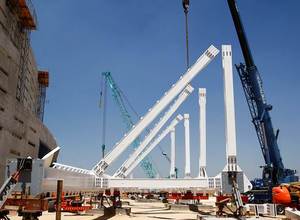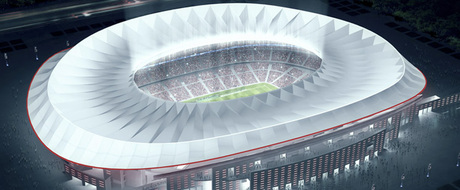Get to know all the details of the roofing of the new stadium
We answer the questions of our fans about this structural element of the project.

We continue with the 'You ask’ section. In this instalment, we tell you all about the roof of the new stadium. After talking about how close the seats will be to the pitch and how the seats will look like, in this instalment we cover the roofing of the new stadium. Today, we answer your questions about this iconic and structural element of what will be our new home.
To contextualize the importance of the engineering work, a few numbers will suffice. The roofing will have an approximate dimension of 286 metres between the North and South ends and 248 meters between the East and the West sides. In fact, its total area will be around 46,500 square meters.
The structure will consist of two steel rings: one on the outside and one on the inside, linked by cables, also made of steel. At the same time, all of this will be covered by glass fibre and polytetrafluorethylene membranes (also called PTFE or Teflon), a translucent material that has already been used in other large stadiums such as Maracanã or Berlin’s Olympic.
46,500
Are the square metres of total surface that the roofing of the new stadium will have.
57
Is the total height in metres that the roofing will have with respect to the pitch.
14
Are the kilometres of steel cable that will be used in the roofing.
In addition, the design of the roof will also help make the sound from the stands reflect in the lower part of the structure, preventing sound waves to leave the stadium, which will make the supporting chants of our fans be even more prominent.
To allow the most sunlight on the grass, the structure will not cover the playing field. In addition, to ensure the best possible lighting, foci will be integrated in the inside ring of the roofing. With respect to the level of the field, the roof will have a minimum height of 45 metres and a maximum of 57.

The work for its placement has been underway for months. The metal skeleton of the roof is being manufactured in La Coruña. On the other hand, the German company Taiyo Europe is responsible for the glass fibre membrane, which will come from Shanghai.
There have also been great advances in the building of the stadium to create the brackets that will raise a structure which, upon completion, will feature no less than 6,000 tonnes of steel, 14 km of steel cable and 83,000 square meters of glass fibre membrane. Impressive numbers that give an idea of the spectacular nature of this structural element that will endow the stadium with lots of personality.


